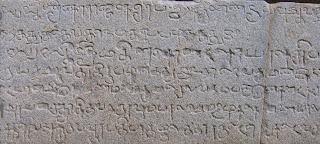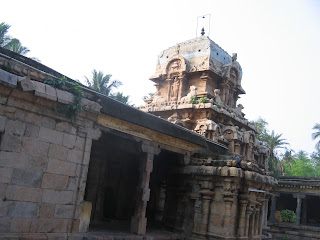Lullaby to Rama that is then followed by the lament of a forlorn father
Kulasekara Azhvaar praises Thiru Kannapuram as a town with fortified walls and the temple with a huge tank
Why hasn't my heart split into two? Dasaratha on being forced to banish his son to the forest
After a couple of decads on Krishna, his love for the Gopis and mother Devaki’s feelings of missing her son through the entire growth phase, Kulasekara Azhvaar dedicates the final three decads of the Perumal Thirumozhi entirely to his favourite Lord Rama.
While the 8th decad comprises of Lullaby to Rama, the 9th one is a lament by Dasaratha on how his old promise to Kaikeyi has come to haunt him at the most inappropriate time and how, as a father, he has had the misfortune of having to banish his beloved son to the forest on the eve of his coronation.
In the 8th decad, he
praises the Lord of Thiru Kannapuram while describing the different events in
Rama’s life. He praises Thiru Kannapuram as a temple surrounded by huge
fortified walls ingrained with gold and the sacred water being holier than the Ganges. He praises
the place as one where Cauvery flowed in full speed. He describes the removal
of weeds and the consequent blooming of lotus flowers in the huge tank. Kannapuram was a place where red lotus grew everywhere around the temple.
கன்னி நன் மா மதில் புடை சூழ் கணபுரத்து என் கருமணியே
களைகழுநீர் மருங்கு அலரும் கணபுரத்து கருமணியே
Kannapuram as a Location
Kannapuram as a Location
Early in the morning he found
bees circling around the temple with a buzzing noise that seemed to be in
melodious tunes. Kannapuram, he says, was a place where learned sages lived and
one where elders resided.
Kannapuram is praised as a temple by the seashore where strong winds washed ashore jewels.
காலின்மணி கரை அலைக்கும் கணபுரத்து என் கருமணியே
Kulasekara Azhvaar praises the Lord of Kannapuram
as one who is seen with fragrant flower garland in his crown.
The Greatness of Rama
Through the verses, he describes
the greatness of Rama through the different events including the removal of the
ten heads of Ravana, the king of Lanka in the South. It was his arrow that pounded the
chest of Tadaka who did not give up till the end.
He praises Rama’s handsome features and sees him as one with lovely locks.His greatness is then brought out through his clan. Rama is praised as the Son in Law of Janaka and as Dasarathi, the descendent of Emperor Dasaratha and as the consort of Mythili.
He praises Rama’s handsome features and sees him as one with lovely locks.His greatness is then brought out through his clan. Rama is praised as the Son in Law of Janaka and as Dasarathi, the descendent of Emperor Dasaratha and as the consort of Mythili.
கொங்கு மலி கருங்குழாள் கௌசலைதன் குலமாதலாய்
தங்கு பெரும் புகழ்ச்சனைகள் திருமருகா தாசரதீ
Leaving charge of the kingdom to
his brother Baratha, who is praised as being the noblest, Rama entered the
blazing forest unmindful of the heat along with his devoted brother.
பார் ஆளும் படர் செல்வம் பரத தம்பிக்கே அருளி
ஆரா அன்பு இளையவனோடு அருங்கானம் அடைந்தவனே
He killed Vali and handed over
the Vanara Kingdom to the younger brother Sugreeva. He describes beautifully in
a verse the event of building a causeway with big boulders and rocks amidst high
waves in the sea
பார் ஆளும் படர் செல்வம் பரத தம்பிக்கே அருளி
ஆரா அன்பு இளையவனோடு அருங்கானம் அடைந்தவனே
Description of Lanka
Lanka is praised as a city with
high fortified walls alongside the huge sea. It had to be his special bow, incomparable
in its features, that he destroyed the huge city.
He makes a comparison of Srirangam
and Thiru Kannapuram.
Dasaratha’s moaning
Kulasekar Azhvaar dedicates an
entire decad, the only such in the entire Nalayira Divya Prabhandham, to
moaning of a desolate Dasaratha.
While the entire city of Ayodhya
was awaiting the coronation and eagerly looking to see Rama as the king, Dasaratha
laments that the step mother has ordered his dear son to the dangerous forest. ‘Listening
to her, I have taken the kingdom away from you. It is a pity this I have done
this.’
You were to lead the royal
elephant of our kingdom. You were to drive the chariot and the horses. But the
harsh words from my cruel tongue has driven you to the wild forest accompanied
by your consort, who looked beautiful adorning the jewels.
Sita’s eyes are praised as being
lovely and long and he compares the sharpness to a spear smeared with ghee. He
asks as to how he would move along the thorny forest and tehn wonders as to
what he could do now having sent him away.
Dasaratha then describes the
physical features of Rama and his valour.
‘His eyes are beautiful and
shoulders long and strong like a mountain. Calling himself a sinner, he says
that his son who was to sleep on the soft bed in the palace has to now learn to
lie down under a leafless tree with the rock as his bed in the cruel forest.
He describes Sita as one whose
hair was decked afresh with flowers and whose beautiful shoulders shone like a
bamboo.
Once again, he is reminded of his
son and asks him to return at least for a while just for a glance.
He wails that it is his past sins
that have damned him to such a state. As he visualizes this dear son straying
away into the forest amidst the deadly wild elephants, Dasaratha wonders as to
how his heart has not yet split into two.
How unfortunate would it be if in
the forest where sharp stones under the heat of the blazing sun cut open the
sole of Rama’s feet causing it to bleed? “You have to now bear the torturous
heat that will cause severe hunger. Listening to the words of my wicked wife, I
have turned a sinner but what can be done now. There is no remedy in place’.
My son may still be calling me
father with his dear sweet voice but I am not able to hear it. No more will I
be able to embrace his chest and be able to enjoy his gentle caress. His steps
when he walked were like elephant’s majestic walk, his face like a blossomed
lotus.
Dasaratha laments as to why he
should still live having sent his Godly son away in a moment of
thoughtlessness.
He calls out for Sumantra and
Sage Vashista and cries out that his son should have been in silk robe but
instead is likely to be in dabha grass. He adds that it was time for him to be
decked with flowers, but he is now with matted plaits. Would not his body be losing
its lustrous beauty.
He then poses a question to Kaikeyi.
By sending out the learned Rama and the beautiful Sita and handing over the
kingdom to Bharata will she not be bring infamy to him and by sending her
husband to his death bed, has she gained anything. He taunts her saying that
they can all enjoy the huge wealth of the land.
He describes the greatness of
Rama by reminding one of the episodes relating to Parasurama. Despite
possessing features that are rare and keeping aside all the greatness (of Rama)
and not considering mother Kausalya’s painful afflictions, it has finally come
down to my earlier promise to Kaikeyi. Nothing else is important now for the
son to fulfill. He lauds the greatness of Rama and says that in all his future
births he would desire a son like him.
Finally, he bids adieu to this
life stating that having left Kausalya and Sumantra in a state of grief and
having had to listen to kaikeyi who was unduly influenced by hunch back Mantra
and meeting her unfair demands, ‘I made my son leave this city that was all set
for festive celebrations.’













